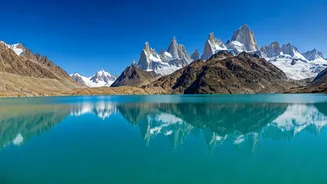Altitude Awareness Essential
Venturing into high-altitude environments presents unique challenges to the human body. Understanding these challenges is the first step towards a successful
and enjoyable trip. Altitude sickness, also known as acute mountain sickness (AMS), is a common ailment that can affect anyone, regardless of fitness level. It occurs when the body struggles to adapt to the reduced oxygen levels at higher altitudes. Symptoms of AMS can range from mild headaches, fatigue, and nausea to more severe conditions like pulmonary edema (fluid in the lungs) and cerebral edema (swelling of the brain). The speed at which you ascend is a critical factor influencing the risk of AMS. Rapid ascents, where you climb too quickly without allowing your body to acclimatize, significantly increase your vulnerability. Proper acclimatization is key, which involves gradually ascending to allow your body to adjust to the lower oxygen levels. This gradual adjustment allows your body to produce more red blood cells and increase oxygen-carrying capacity.
Planning Your Ascent
Thoughtful planning is vital when preparing for high-altitude adventures. Before embarking on your journey, research the altitude of your destination and the elevation gain involved. Check weather forecasts and be prepared for rapidly changing conditions, including significant temperature drops, intense sunlight, and potential snow or rain. Pack accordingly with layers of clothing to adjust to varying temperatures. Include essential gear like a warm hat, gloves, waterproof outerwear, and sturdy hiking boots. Consider bringing a first-aid kit containing medications for altitude sickness (like acetazolamide, if prescribed by your doctor), pain relievers, and any personal medications. It is very important to consult your doctor before your trip, especially if you have underlying health conditions, such as heart or lung problems. Discuss your travel plans, receive medical advice, and get any necessary vaccinations.
Acclimatization Strategies
Acclimatization is the cornerstone of a safe high-altitude experience. It gives your body time to adapt to lower oxygen levels and minimize the risk of altitude sickness. The most effective acclimatization strategy is to ascend gradually. This allows your body to adjust slowly. When possible, follow the 'climb high, sleep low' rule. During the day, hike to a higher altitude and then descend to sleep at a lower elevation. This helps the body acclimatize overnight. Adequate hydration is crucial at high altitudes, as the air is dry, and you lose fluids faster. Drink plenty of water throughout the day. Avoid alcohol and excessive caffeine, as they can dehydrate you and exacerbate altitude sickness symptoms. Pay attention to your body's signals. If you experience symptoms of altitude sickness, such as headache, nausea, or dizziness, descend to a lower altitude immediately. This can often alleviate the symptoms.
Nutrition and Hydration
Proper nutrition and hydration play a crucial role in maintaining your energy levels and aiding acclimatization at high altitudes. Consume a diet rich in carbohydrates, as they are a primary fuel source for your body during exertion. Carbohydrates help provide sustained energy needed to perform tasks, while your body acclimatizes. High-altitude environments can cause increased fluid loss due to drier air and increased respiration. Staying adequately hydrated supports your body's physiological functions and helps prevent dehydration, which can worsen altitude sickness. Drinking ample water throughout the day is essential, as are electrolyte-rich drinks to replenish lost minerals. Avoid heavy meals before strenuous activity, as digestion can divert blood flow away from vital organs. Instead, opt for frequent, smaller meals and snacks. Pack energy-dense foods, like nuts, dried fruits, and energy bars, that are easy to carry and provide quick energy boosts during your hikes.
Capturing Breathtaking Views
High-altitude locations offer stunning panoramic views and breathtaking scenery, making them a photographer's paradise. When preparing your camera gear, consider the challenges of high-altitude photography. The thin air at high altitudes can affect camera sensors and batteries, so ensure that you have extra batteries on hand. Protect your camera from harsh elements, such as intense sunlight, rain, and snow, using a weather-resistant camera bag. To maximize your photographic opportunities, research the best times of day to capture the scenery, like the golden hour (shortly after sunrise and before sunset), to get softer light. Practice proper composition techniques and utilize the surrounding landscape to enhance your photos. Use a tripod for stability, especially in windy conditions, to avoid blurry images. Remember to take time to appreciate the beauty around you and enjoy the moment, even if you are preoccupied with capturing the perfect shot.
Exploring Remote Locations
Discovering remote locations offers a unique sense of adventure and provides opportunities for solitude and immersion in nature. Research the permits and regulations required for visiting the area. Some areas may require permits for hiking, camping, or photography, so make sure you are in compliance. Pack all essential supplies, including sufficient food, water, navigation tools (map, compass, and GPS), first-aid kit, and emergency equipment. Inform someone about your travel plans, including your itinerary, the locations you will be visiting, and your expected return date. Consider learning basic survival skills, like building a shelter, starting a fire, and identifying edible plants. Respect local cultures and customs when interacting with the communities. Embrace the remoteness and the challenges it presents, allowing yourself to be humbled by the raw beauty of the natural environment and making memories that will last a lifetime.
Water Activities & Safety
High-altitude lakes offer opportunities for water activities such as swimming, boating, and fishing. Be aware of the risks involved and take appropriate precautions. The water in high-altitude lakes is often very cold, which can lead to hypothermia even in seemingly warm weather. Wear appropriate clothing, such as a wetsuit, if you plan to enter the water. If swimming, ensure you are a strong swimmer and swim with a buddy. Always wear a life jacket when boating. The thin air at high altitudes can cause sun-related hazards, like sunburns and sunstroke. Wear protective clothing, including a hat and sunglasses, and apply sunscreen liberally and frequently. Be cautious of strong winds, which can create dangerous conditions on the water. Check the weather forecast before engaging in any water activities and be prepared to change your plans if conditions become unsafe.












